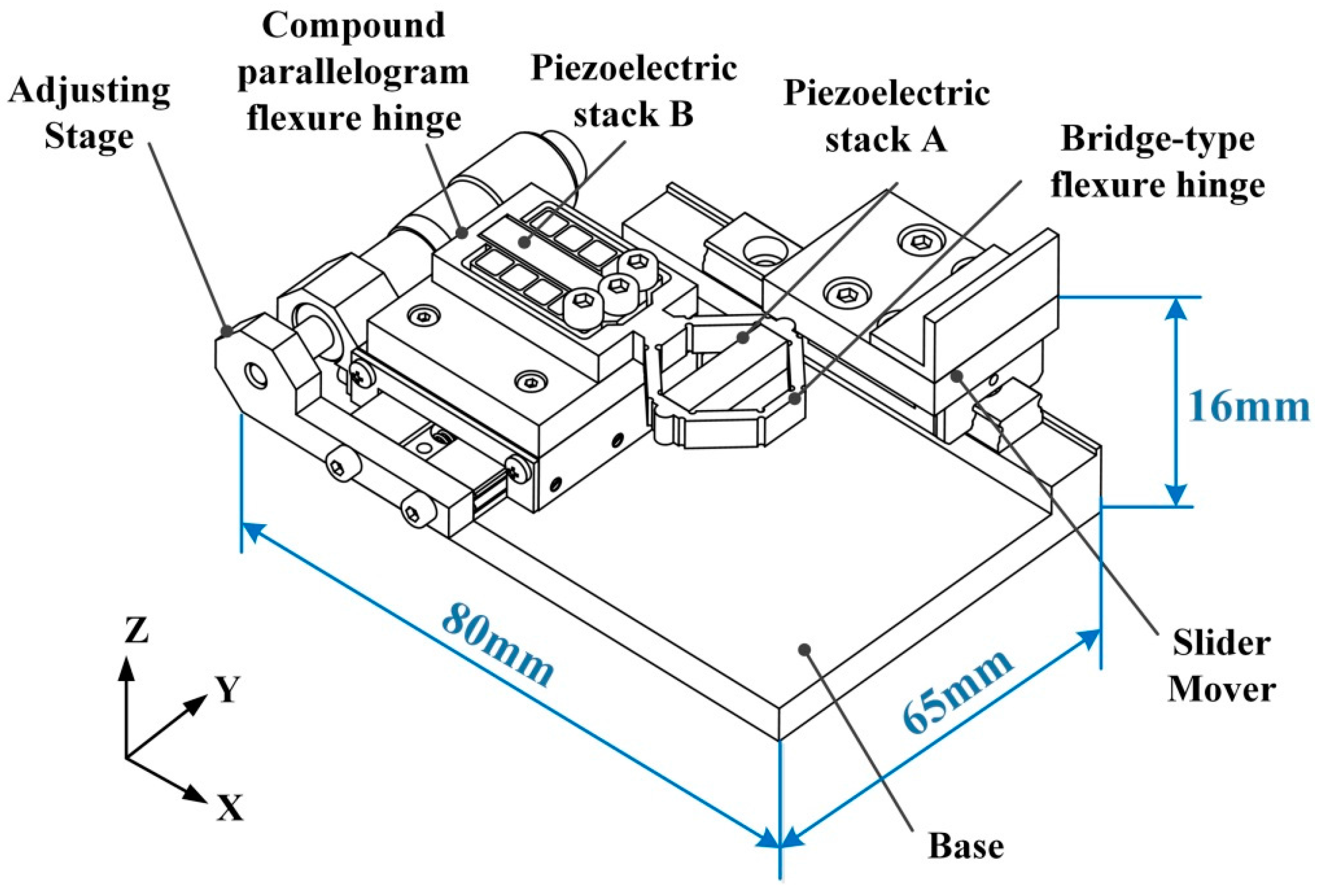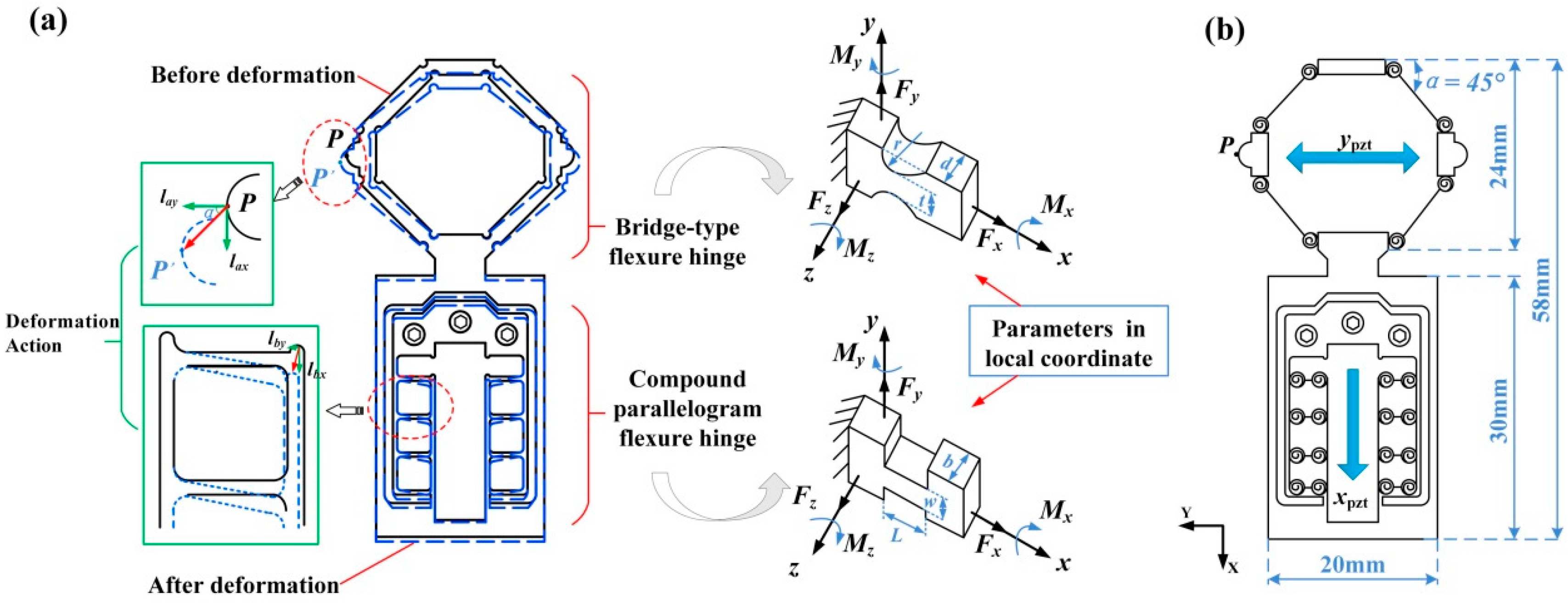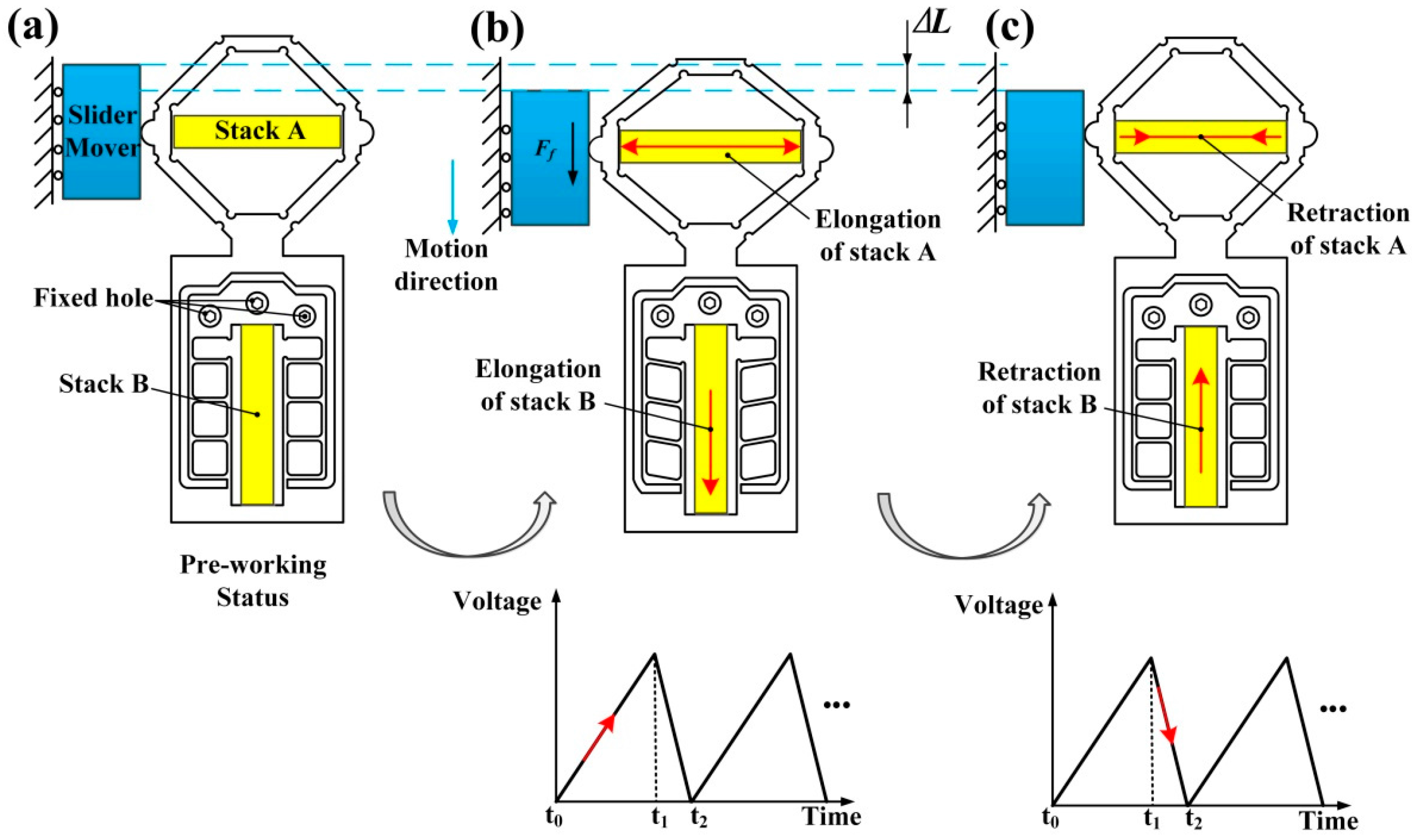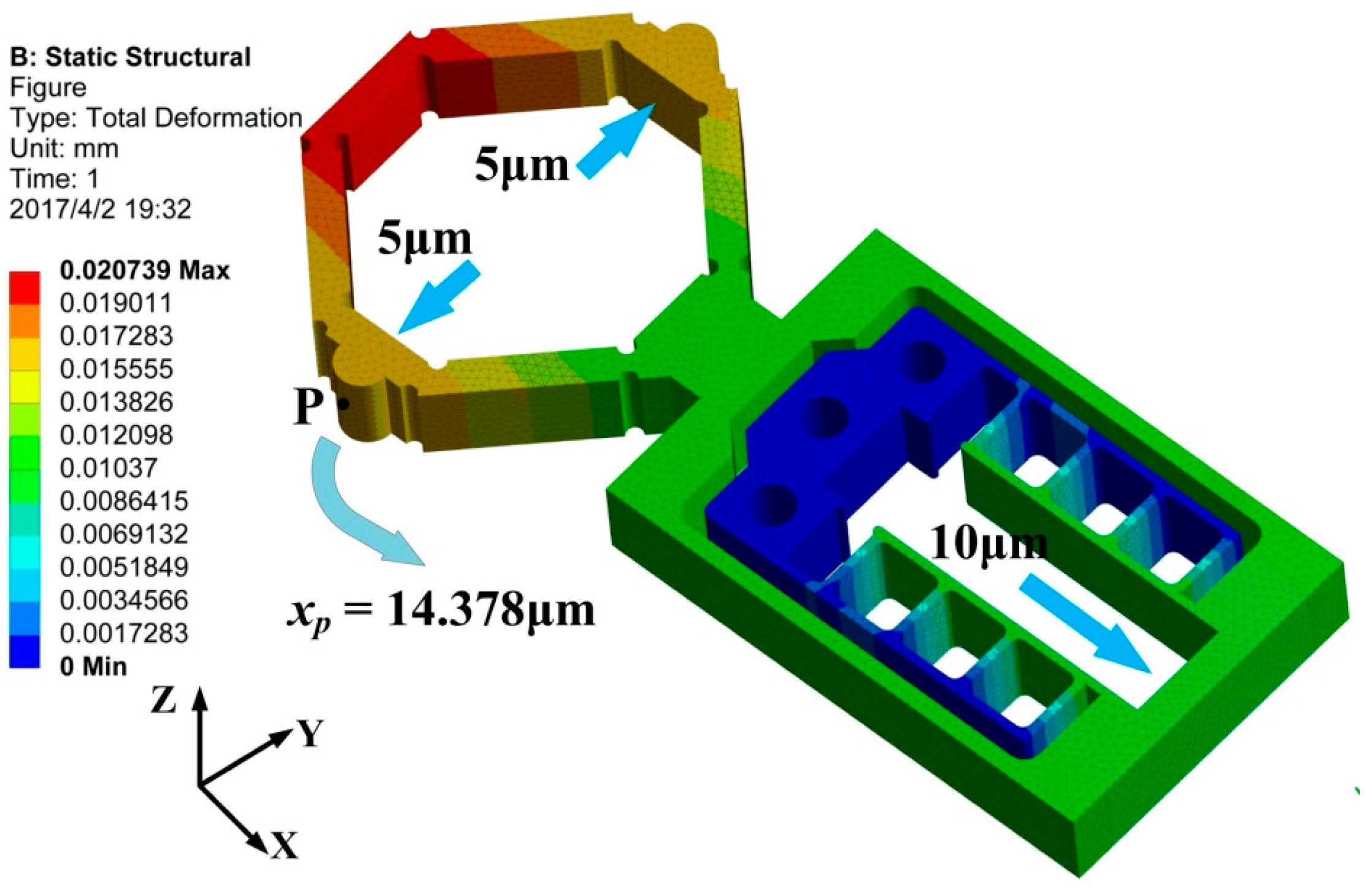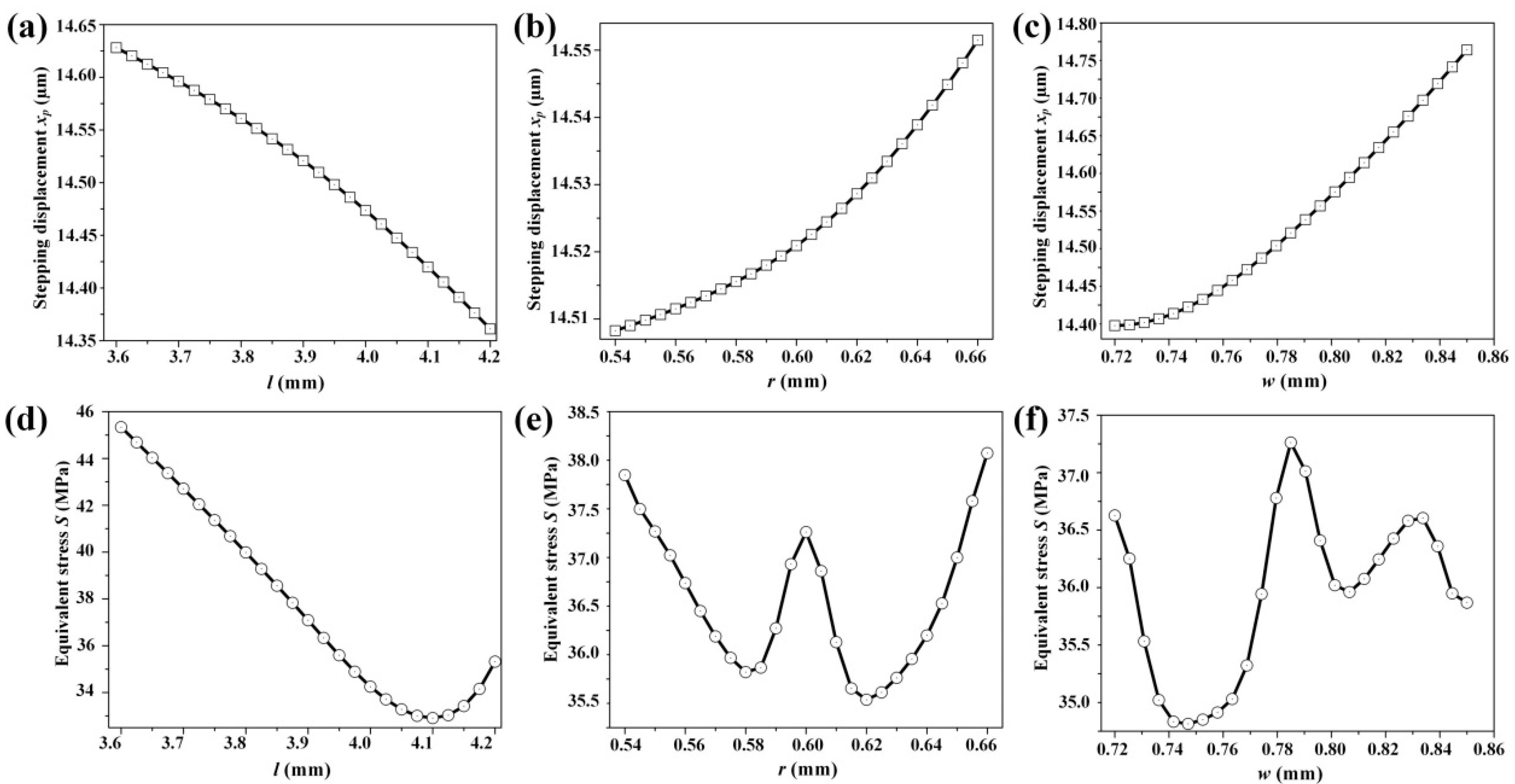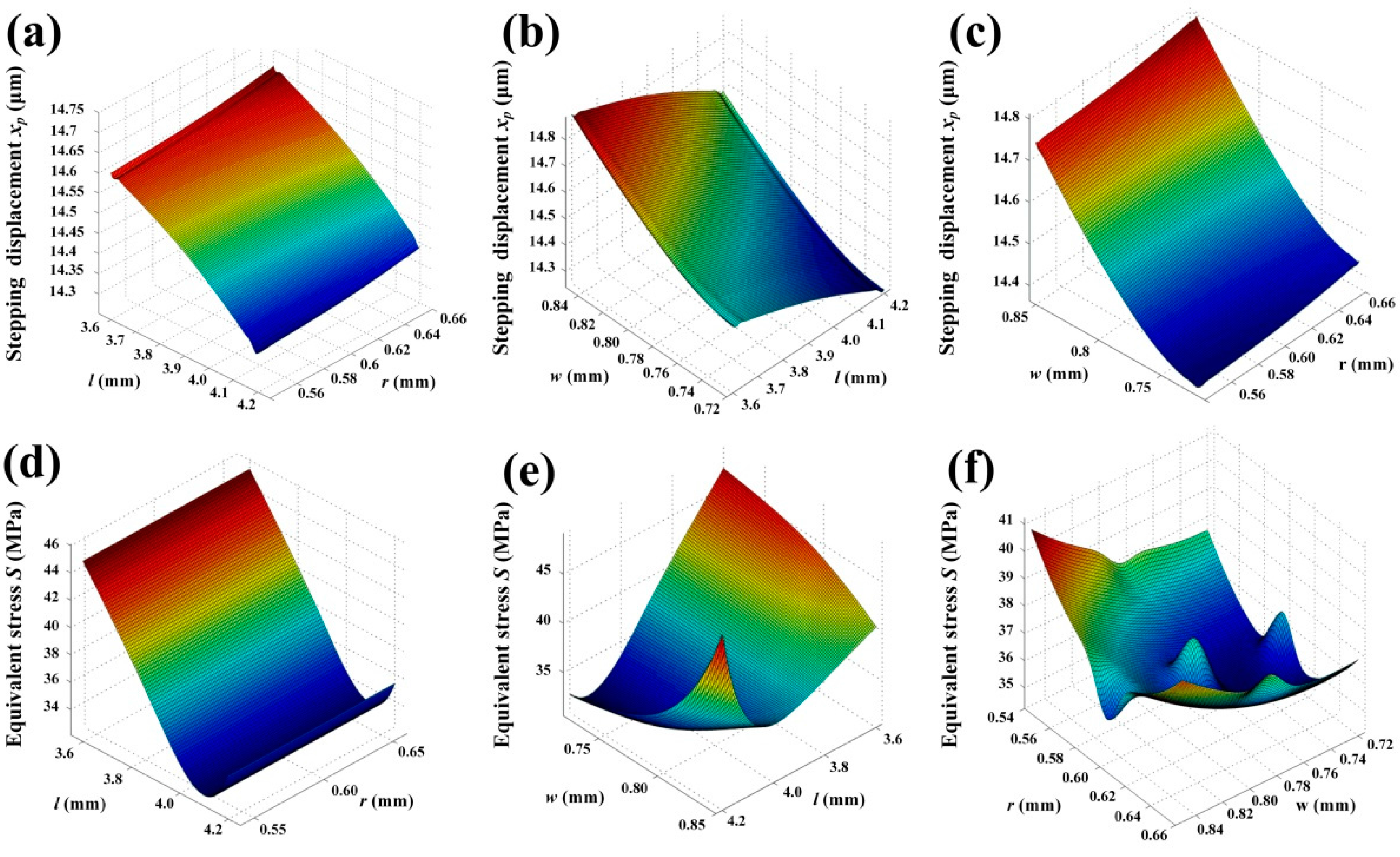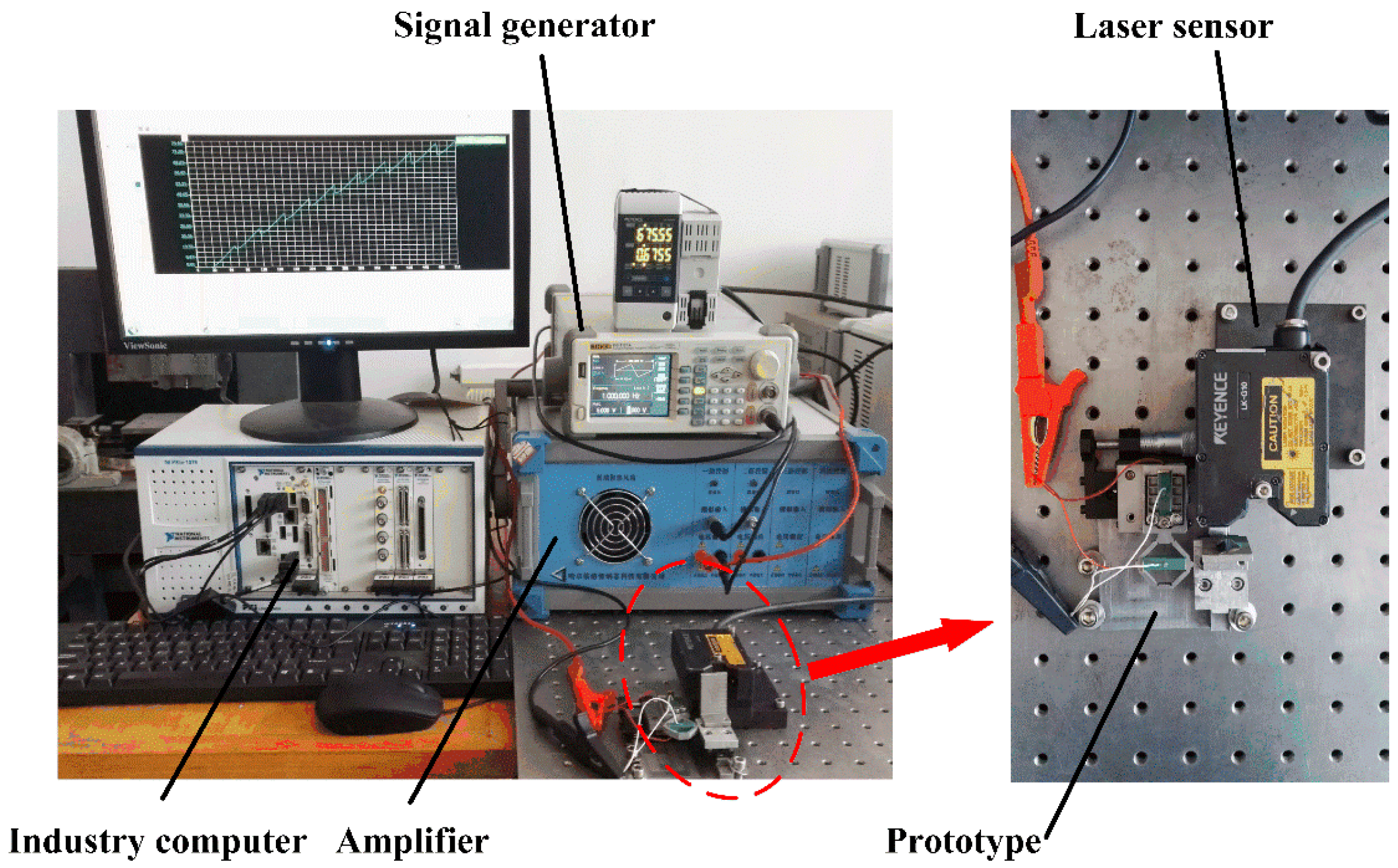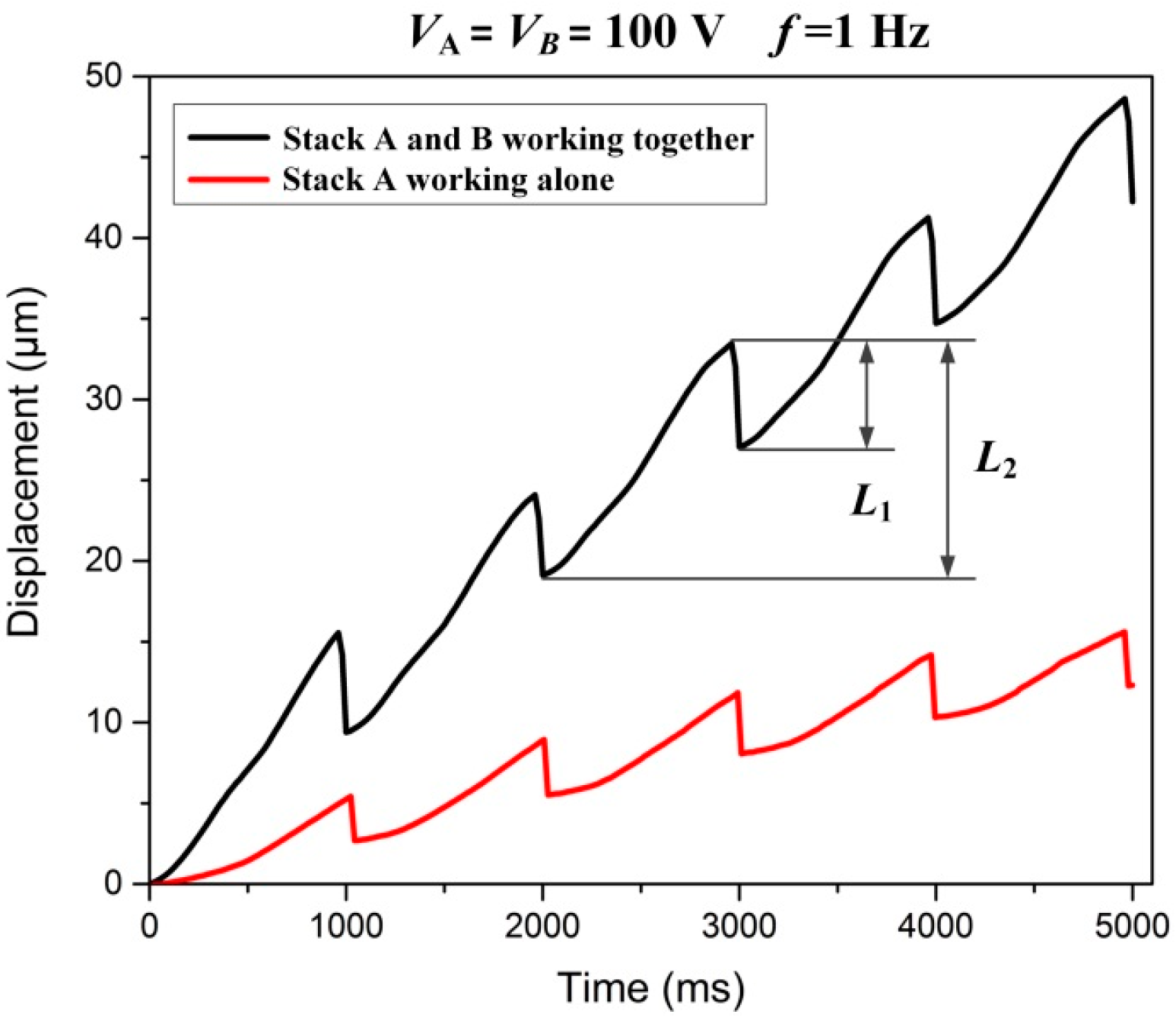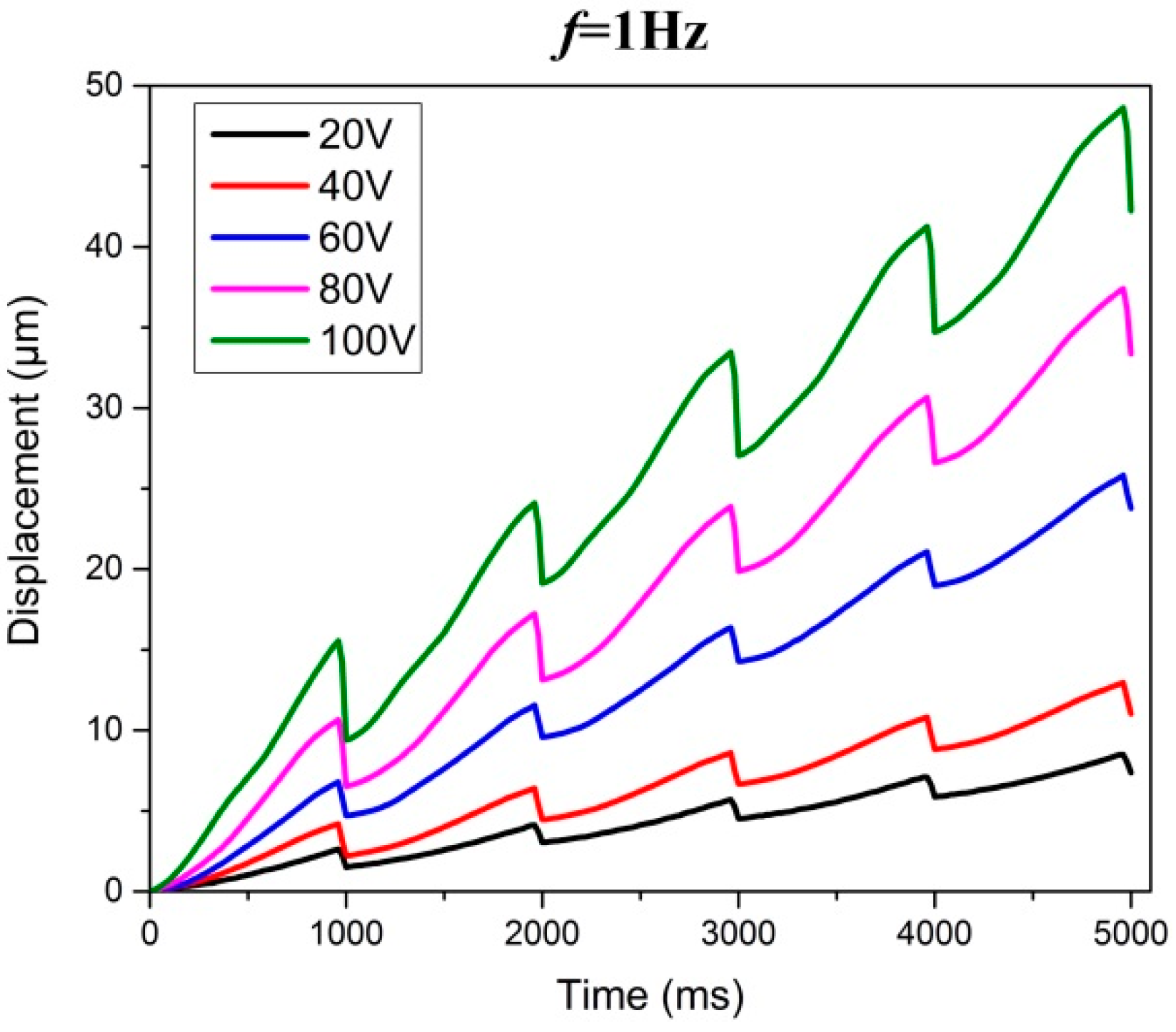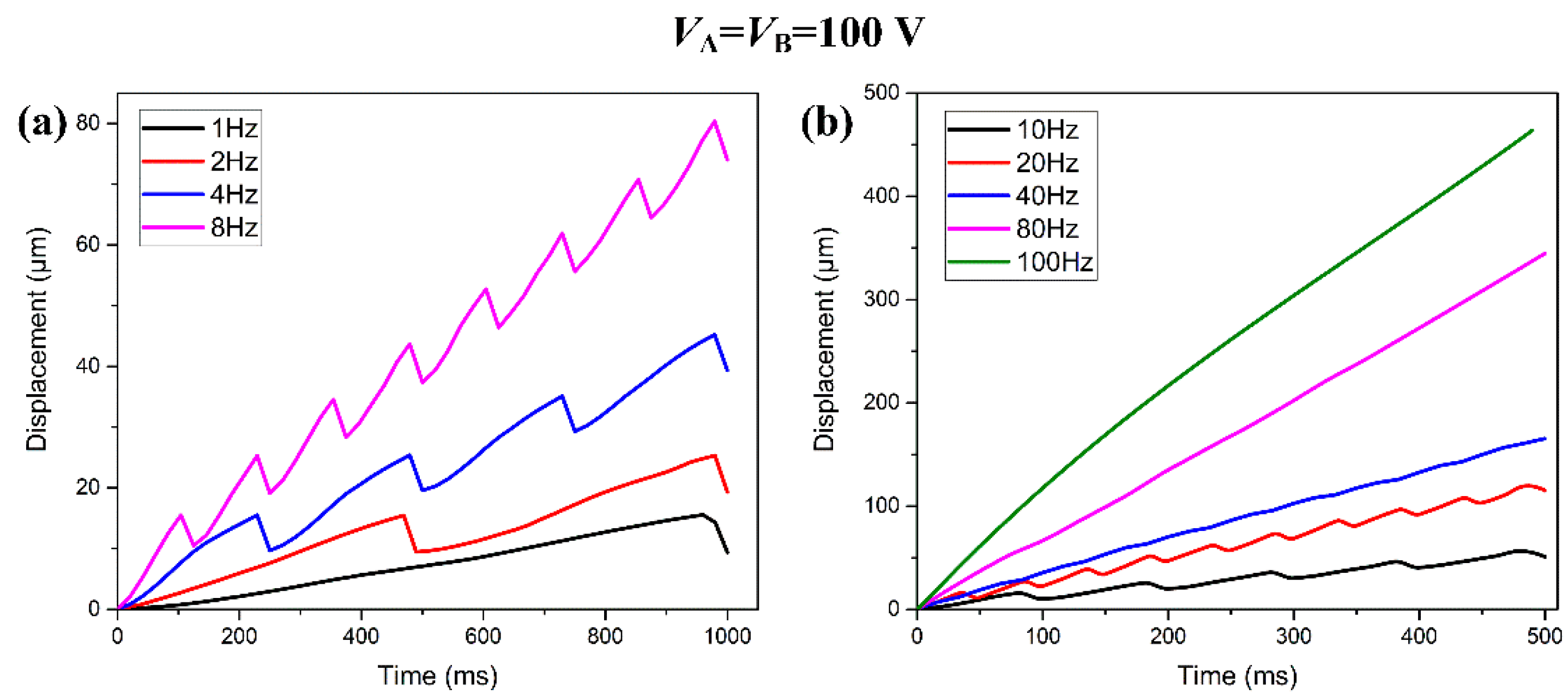1. Introduction
With the rapidly-growing demand for high accuracy in micro-nano fabrication and optical systems, designing high-accuracy nanopositioning systems has become more and more significant. Given the advantages of high-resolution, large output force, and rapid response, the piezoelectric nanopositioning stage has attracted widespread attention from researchers all over the world. In addition, many types of piezoelectric driven actuators have been successfully developed in the field of precision nanopositioning [
1,
2,
3]. Regarding their working principles, piezoelectric actuators can be mainly divided into ultrasonic actuators, direct driving actuators, inchworm actuators, stick-slip actuators and so on. Nevertheless, all kinds of these piezoelectric-driven actuators have both advantages and disadvantages. Ultrasonic actuators have high-speed motion and rapid response, but the stability of the motion and heat generation are still problematic [
4,
5,
6]. Direct-driving actuators have large output force and displacement and, furthermore, their structure can be compact and can achieve rapid responses with high resolutions; however, their operating stroke is limited [
7,
8,
9]. Inchworm actuators have large motion ranges by stepping motions, and the output force is large, but the control system and mechanical structure are relatively complex [
10,
11,
12]. A large amount of research still needs to be accomplished to overcome all of these actuators’ shortcomings and to develop new types of piezoelectric actuators.
Nanopositioning actuators have been used in many applications. A number of applications need both nanoscale resolutions and large travel. Stick-slip actuators present the advantage to allow long displacements (several centimeters or even more) at a high speed (several mm/s) with an ultra-high resolution. Moreover, they are simple, compact, and offer a high stiffness. They are, therefore, perfectly well adapted to challenging applications, such as nanopositioning [
13,
14,
15]. For example, Zhang et al. [
16] presented a two-DOF (degree of freedom) rotary-linear actuator based on the stick-slip principle, which could achieve both linear displacement and angular displacement with the sequential coordination of three piezoelectric stacks. Nevertheless, when the coaxiality between actuator shaft and friction piece is not ideal, the vertically-distributed preload screw cannot provide a steady tightening force to balance the actuator shaft, implying that in order to achieve steady stick-slip motion, relatively high assembly accuracy is needed. Stieg et al. [
17] proposed an inertial drive actuator for coarse and fine approaches in scanning probe microscopy, and it could perform clamping action by magnetic force without generating mechanical wear. However, the normal force between the slider element and drive body is constant, thus, the acceleration effects of gravity would lead to the slider element’s displacement loss in each working circle, so the stepping resolution and the stability of the stepping motion is limited. Li et al. [
18] developed a stick-slip type linear actuator based on the lateral motion principle, it can realize fine linear motion by the flexure hinge’s parasitic movement, but there will be serious hysteresis and creep phenomena when the flexure hinge working under the high-frequency condition. So far, existing techniques in the design of piezo-driven stick slip actuators still cannot ensure high resolution, while meeting the requirements of achieving large stroke motion. Seldom have researchers paid attention to the unadjustable normal force between the mover and stator, which would restrict stepping resolution and motion speed of a stick-slip actuator to a great extent.
Inspired by the above studies and the need for advanced stick-slip actuators, this paper proposes an actuator that can achieve both stable large-stroke and high-resolution linear motion, and the normal force between the stator and mover can be effectively adjusted with the help of adjusting an adjustable stage. The developed actuator mainly consists of a bridge-type flexure hinge mechanism, a compound parallelogram flexure hinge mechanism, and two piezoelectric stacks. Two kinds of working modes of this designed actuator are presented to realize different functions. When the piezo-stack that nested in the bridge-type flexure hinge mechanism works alone, the parasitic motion of the bridge-type flexure hinge mechanism enables the slider mover to achieve high-resolution fine motion, which can be applied in precise compensation for the position error. On the other hand, when two piezo-stacks that are nested in different flexure hinge mechanisms work together, the slider mover will achieve large stepping displacement motion due to the action of the compound parallelogram flexure hinge. This working mode can be brought into the adjustment of coarse positioning. This means the combination of two kinds of flexure hinge mechanisms enable the actuator to have a significant enhancement both in resolution of the stepping motion and the working stroke.
Additionally, a series of experiments and finite element analysis methods were carried out to test the performance of the designed piezoelectric actuator. The proposed actuator may have some significance for designing stick-slip actuators and potential applications for a high-precision micro/nano-system.
2. Design and Analysis
The structure of designed stick-slip piezoelectric actuator is illustrated in
Figure 1. It can be clearly seen that the actuator mainly consists of a base, an adjusting stage, a slider mover, two piezoelectric stacks, a bridge-type flexure hinge, and a compound parallelogram flexure hinge. The adjusting stage (TSM13-2A from Zolix Company, Beijing, China) is made up of a linear spherical guide, an adjusting micrometer-knob and a moving platform. The flexure hinge mechanism is assembled on the top of the moving platform, and the moving platform is mounted on linear spherical guide. When turning the adjusting micrometer-knob, the fine motion of the moving platform is used to change preload normal force between slider mover and flexure hinge. Two piezoelectric stacks, nested in the bridge-type flexure hinge mechanism and a compound parallelogram, respectively, are exploited to deform the flexure hinge. A linear guide and a slider (SRS-9M from THK Company, Tokyo, Japan) are used as the mover for their high-carrying capacity and small-friction coefficient. All of the components are assembled on the base carefully. Since the assembling errors may influence the preload force, some adjustment work needs to be done to keep the working motion smooth after the assembly.
The geometric model of the bridge-type flexure hinge and compound parallelogram flexure hinge mechanism are shown in
Figure 2. The key parameters of the designed flexure hinge mechanism are listed in
Table 1. As the piezoelectric stack A receives power, it will deform the bridge-type flexure hinge both in
y direction and
x direction. The displacement
lay is the motion displacement generated along the elongation direction of piezoelectric stack A, The displacement
lax is lateral motion, and it is used to push the slider mover to move along the
x direction. Additionally, when the piezoelectric stack B gets charged, it will extend along the
x direction, then it pushes the compound parallelogram flexure hinge to deform both in the
x and
y directions, as well. However, due to the structural stiffness, the compound parallelogram flexure hinge will only deform a very small distance in the
y direction, namely
lby, and it can be ignored when compared with the large displacement in the
x direction
lax. That is to say, the elongation of stack B can be entirely used to enlarge the stepping displacement of the slider mover in the
x direction.
Based on the stick-slip principle, an asymmetrical sawtooth-wave voltage is applied to drive the piezoelectric stack, and the percentage of stacks’ charging time in a working circle is set to be 80%. The working process of a working circle about this designed actuator can be divided into two steps, as shown in
Figure 3. From time
t0 to
t1, both piezoelectric stack A and B slowly obtain power, the piezoelectric stack A will push the bridge-type flexure hinge to move a certain distance both in the
x and
y directions, and the stack B extends slowly to push the compound parallelogram flexure hinge in the
x direction as well. Since the bridge-type flexure hinge is holding the slider through the preload force, theoretically, the friction force between the slider mover and bridge-type flexure hinge is a static friction force, thus, under the deformation action of compound parallelogram flexure hinge, the piezoelectric stack B will push both the slider mover and piezoelectric stack A to move a small displacement ∆
L, which is shown in
Figure 3b; From time
t1 to
t2, piezoelectric stack A and B discharge quickly, resulting in the swift retraction of both the bridge-type flexure hinge and compound parallelogram flexure hinge to their initial position. The friction force between the flexure hinge and slider mover changes to be the sliding friction force. Nevertheless, due to the action of inertial force, the slider mover will stay nearly at the same position as in
Figure 3b. Consequently, the slider moves forward one step displacement unit ∆
L while the flexure hinge return to its initial position. As the sawtooth driving voltage increases and decreases cyclically, stick and slippage of the slider occur iteratively; hence, the slider is driven through an extended travel range, which is shown in
Figure 3c.
Regarding the contact point P between the mover slider and bridge-type flexure hinge, the stepping displacement
xp of point P can be considered as the sum of
lax and
lbx:
Here, lax is the moving distance in x direction caused by piezoelectric stack A, and lbx is the moving distance in the x direction caused by the piezoelectric stack B.
According to the previous works [
19,
20,
21], the relationship between motion displacement of the bridge-type flexure hinge in the
x and
y directions can be obtained from the following equation:
Here, ypzt is the elongation of piezoelectric stack A, and α denotes the inner angle of bridge-type flexure hinge, namely 45°.
Since the motion displacement in the
x direction of piezoelectric stack B is fully used to push the slider mover, the moving distance caused by stack B can be written as follows, where
xpzt represents the elongation of piezoelectric stack B:
As above mentioned, Equation (1) can be equivalent to the following:
The finite element analysis method (FEM) is adopted to investigate the working performance of the designed flexure hinge mechanism. The software ANSYS Workbench 15.0 is used to simulate in this study. The finest 3D tetrahedron element is used to mesh the model of the designed flexure hinge. Additionally, the piezoelectric stacks used are set as rigid bodies and the displacement controlled way is used for them. This is mainly due to the fact that the displacement of piezoelectric is approximately proportional to the driving voltage. When the driving voltage is 100 V, the elongation of piezoelectric stacks A and B from NEC is about 10 μm. Three screw holes are fully fixed during the simulation. The material used for the flexure hinge is Al 7075 and the main parameters are shown in
Table 2.
The result of the FEM is illustrated in
Figure 4, and it can be seen that the moving distance of point P in the
x direction is 14.378 μm, which is nearly equal to the value obtained from Equation (4), namely 15 μm. Theoretically, the error may be due to the computational accuracy of the finite element method.
3. Optimization
In the past decades, structural optimization has been extensively explored and successfully applied to optimize structures and mechanisms in many practical engineering designs with the use of FEA [
22]. The purpose of the optimization process for the flexure hinge mechanisms is to obtain optimal design parameters to achieve the maximum stepping displacement while taking into account of the stress concentration occurred in the flexural hinges. Generally, the radius
r, thickness
w, and length of rigid links
l are the three important structural factors to the static performances of the flexure hinge, and these parameters are chosen as the design variables. Thus, the above multiple-objective optimization problem in this research is briefly described in the standard mathematical format as:
Since the response surface methodology (RSM) is a kind of mathematical and statistical technique that can be used to explore the relationships between several explanatory variables and one or more response variables [
23], an optimization process is carried out in the commercial software ANSYS Workbench 15.0 to quickly reflect effects of different parameters on performance characteristics of the flexure hinge mechanism. Regarding the created response charts and surfaces, change trends of displacement and equivalent stress with designing parameters of flexure hinge mechanism are shown in
Figure 5 and
Figure 6. It can be noted that when
l increases, the displacement and stress decrease slowly, as shown in
Figure 5a,d. When
r and
w increase, their displacement quickly increase, as shown in
Figure 5b,c. The stress will show slight increases when
r increases, as shown in
Figure 5e. Seen in
Figure 6b,e, the sensitivities of both displacement and stress with
w and
l are considerately higher than with others. As illustrated in
Figure 6a,c,
r seems to have little influence on the displacement.
After computational analysis, the potential candidates are compared and estimated to find the best candidate, which can be seen in
Table 3. According to
Table 3, Candidate 1 was selected as the best optimal design because it completely satisfies the first design objectives: the maximum displacement
xp was the highest among the candidates, and the maximum equivalent stress was still well below the yield strength of the material (505 MPa). Compared with the initial design, the static characteristics of the actuator was relatively improved, as seen in
Table 3: (i) the stepping displacement was increased up to 2.99%; and (ii) the maximum stress was decreased by approximately 4.95%.
